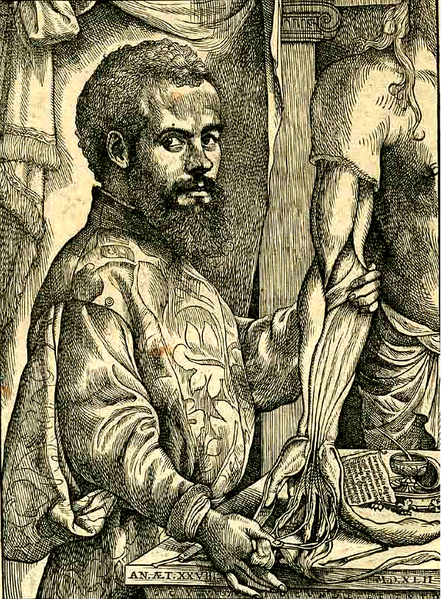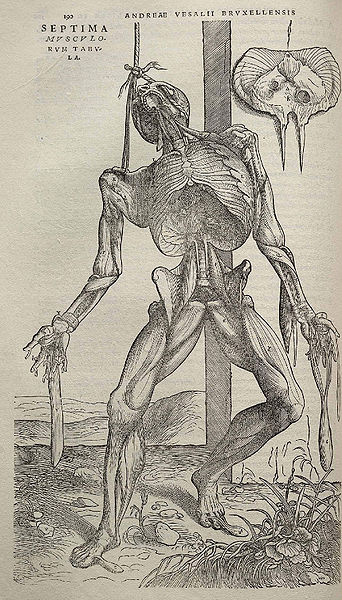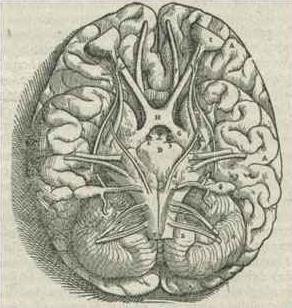<Back to Index>
- Anatomist Andreas Vesalius, 1514
- Writer Marie Catherine Sophie de Flavigny, Comtesse d'Agoult (Daniel Stern), 1805
- Khedive of Egypt and Sudan Ismail Pasha, 1830
PAGE SPONSOR



Andreas Vesalius (December 31, 1514 – October 15, 1564) was an anatomist, physician, and author of one of the most influential books on human anatomy, De humani corporis fabrica (On the Fabric of the Human Body). Vesalius is often referred to as the founder of modern human anatomy. Vesalius is the Latinized form of Andreas van Wesel. He is sometimes also referred to as Andreas Vesal and Andre Vesale.
Vesalius was born to Andries van Wesele and Isabel Crabbe on Dec. 31, 1514, in Brussels, then in the Habsburg Netherlands, to a family of physicians. His great-grandfather, Jan van Wesel, probably born in Wesel, received his medical degree from the University of Pavia and taught medicine in 1428 at the then newly founded University of Leuven. His grandfather, Everard van Wesel, was the Royal Physician of Emperor Maximilian, while his father, Andries van Wesel, went on to serve as apothecary to Maximillian, and later a valet de chambre to his successor Charles V. Andries encouraged his son to continue in the family tradition, and enrolled him in the Brethren of the Common Life in Brussels to learn Greek and Latin according to standards of the era.
In 1528 Vesalius entered the University of Louvain (Pedagogium Castrense) taking arts, but when his father was appointed as the Valet de Chambre in 1532, he decided to pursue a career in medicine at the University of Paris, where he moved in 1533. Here he studied the theories of Galen under the auspices of Jacques Dubois (Jacobus Sylvius) and Jean Fernel. It was during this time that he developed his interest in anatomy, and was often found examining bones at the Cemetery of the Innocents.
Vesalius
was forced to leave Paris in 1536 due to the opening of hostilities
between the Holy Roman Empire and France, and returned to Leuven. Here he completed his studies under Johann Winter von Andernach and graduated the next year. His thesis, Paraphrasis in nonum librum Rhazae medici arabis clariss. ad regem Almansorum de affectuum singularum corporis partium curatione, was a commentary on the ninth book of Rhazes. He remained at Leuven only briefly before leaving after a dispute with his professor. After settling briefly in Venice in 1536, he moved to the University of Padua (Universitas artistarum) to study for his doctorate, which he received in 1537. On graduation he was immediately offered the chair of Surgery and Anatomy (explicator chirurgiae) at Padua. He also guest lectured at Bologna and Pisa. Previously these topics had been taught primarily from reading classic texts, mainly Galen,
followed by an animal dissection by a barber - surgeon whose work was
directed by the lecturer. No attempt was made to actually check Galen's
claims; these were considered unassailable detailed anatomical
diagrams, the first accurate set to be produced. Many of these were
produced by commissioned artists, and were therefore of much better
quality than those produced previously. In
1541, while in Bologna, Vesalius uncovered the fact that all of Galen's
research had been based upon animal anatomy rather than the human;
since dissection had been banned in ancient Rome, Galen had dissected Barbary Apes instead,
and argued that Galen assumed arteries carried the purest blood to
higher organs such as the brain and lungs from the left ventricle of
the heart, while veins carried blood to the lesser organs such as the
stomach from the right ventricle. In order that this theory could be
correct some sort of holes were needed to interconnect the ventricles,
and so in the spirit of Galen's time, he claimed to have found them,
adjusting the facts to suit his theory. So paramount was the authority
of Galen that for the next 1400 years, a succession of anatomists
claimed to find these holes until finally Vesalius declared he could
not find them. However, while Vesalius dared to admit he could not find
these holes, he did not dream of disputing Galen on the distribution of
blood, and so imagined it distilled through the unbroken partition
between the ventricles. Other
famous examples of Vesalius disproving Galen in particular was his
discovery that the lower jaw was only one bone, not two (which Galen
had assumed from animal dissection) and his proof that blood did not
pass through the interatrial septum. In 1543, Vesalius conducted a public dissection of the body of Jakob Karrer von Gebweiler, a notorious felon from the city of Basel, Switzerland. With the cooperation of the surgeon Franz Jeckelmann, he assembled the bones and finally donated the skeleton to the University of Basel.
This preparation ("The Basel Skeleton") is Vesalius' only
well-preserved skeletal preparation today, and is also the world's
oldest anatomical preparation. It is still displayed at the Anatomical
Museum of the University of Basel. Later that year Vesalius asked Johannes Oporinus to help publish the seven volume De humani corporis fabrica (On the fabric of the human body), a groundbreaking work of human anatomy he dedicated to Charles V. Most believe it was illustrated by Titian's pupil Jan Stephen van Calcar. A few weeks later he published an abridged edition for students, Andrea Vesalii suorum de humani corporis fabrica librorum epitome, and dedicated it to Philip II of Spain, son of the Emperor. Though
Vesalius' work was not the first such work based on actual autopsy, nor
even the first work of this era, the production values, highly detailed
and intricate plates, and the fact that the artists who produced it
were clearly present at the dissections themselves made it into an
instant classic. Pirated editions were available almost immediately, a
fact Vesalius acknowledged would happen in a printer's note. Vesalius was 30 years old when the first edition of Fabrica was published. Soon after publication, Vesalius was invited as Imperial physician to the court of Emperor Charles V. He informed the Venetian Senate that he was leaving his post in Padua, which prompted Duke Cosimo I de' Medici to
invite him to move to the expanding university in Pisa, which he turned
down. Vesalius took up a position in the court, where he had to deal
with the other physicians mocking him as being a barber. Over
the next eleven years Vesalius travelled with the court, treating
injuries from battle or tournaments, performing pastes and postmortems,
and writing private letters addressing specific medical questions.
During these years he also wrote Radicis Chynae,
a short text on the properties of a medical plant, whose use he
defended, as well as defense for his anatomical findings. This elicited
a new round of attacks on his work that called for him to be punished
by the emperor. In 1551, Charles V commissioned an inquiry in Salamanca to
investigate the religious implications of his methods. Vesalius' work
was cleared by the board, but the attacks continued. Four years later
one of his main detractors published an article that claimed that the
human body itself had changed since Galen had studied it. After
the abdication of Emperor Charles V he continued at court in great
favour with his son Philip II, who rewarded him with a pension for life
and by being made a count palatine. In 1555 he published a revised
edition of De Corporis. In 1564 Vesalius went on a pilgrimage to the Holy Land. He sailed with the Venetian fleet under James Malatesta via Cyprus. When he reached Jerusalem,
he received a message from the Venetian senate requesting him again to
accept the Paduan professorship, which had become vacant by the death
of his friend and pupil Fallopius. After struggling for many days with the adverse winds in the Ionian Sea, he was wrecked on the island of Zakynthos.
Here he soon died in such debt that a benefactor kindly paid for his
funeral. At the time of his death he was scarcely fifty years of age. For many years it was assumed that Vesalius's pilgrimage was due to pressures of the Inquisition.
Today this is generally considered to be without foundation and is
dismissed by modern biographers. It appears the story was spread by Hubert Languet, who served as de Saxe under Emperor Charles V and then under the Prince of Orange,
who claimed in 1565 that Vesalius was performing an autopsy on an
aristocrat in Spain when it was found that the heart was still beating,
leading to the Inquisition condemning him to death. The story went on
to claim that Philip II had the sentence transformed into a pilgrimage.
The story re-surfaced several times over the next few years, living on
until recent times. In 1543, Vesalius asked Johannes Oporinus to help publish the seven volume De humani corporis fabrica (On the fabric of the human body), a groundbreaking work of human anatomy he dedicated to Charles V and which most believe was illustrated by Titian's pupil Jan Stephen van Calcar,
though others believe was illustrated by different artists working in
the studio of Titian, and not from Van Calcar himself. A few weeks
later he published another version of his opera, entitled De humani corporis fabrica librorum epitome (Abridgement of the Structure of the Human Body) more commonly known as Epitome, with a stronger focus on illustrations than text, so as to help readers easily understand his findings. The actual text of Epitome was an abridged form of his work in De fabrica, and the organization of the two books were quite varied. He dedicated it to Philip II of Spain, son of the Emperor. The Fabrica emphasized
the priority of dissection and what has come to be called the
"anatomical" view of the body, seeing human internal functioning as an
essentially corporeal structure filled with organs arranged in
three dimensional space. This was in stark contrast to many of the
anatomical models used previously, which had strong
Galenic/Aristotelean elements, as well as elements of astrology. Although modern anatomical texts had been published by Mondino and Berenger, much of their work was clouded by their reverence for Galen and Arabian doctrines. Besides the first good description of the sphenoid bone, he showed that the sternum consists of three portions and the sacrum of five or six; and described accurately the vestibule in
the interior of the temporal bone. He not only verified the observation
of Etienne on the valves of the hepatic veins, but he described the vena azygos, and discovered the canal which passes in the fetus between the umbilical vein and the vena cava, since named ductus venosus. He described the omentum, and its connections with the stomach, the spleen and the colon; gave the first correct views of the structure of the pylorus; observed the small size of the caecal appendix in man; gave the first good account of the mediastinum and pleura and
the fullest description of the anatomy of the brain yet advanced. He
did not understand the inferior recesses; and his account of the nerves
is confused by regarding the optic as the first pair, the third as the
fifth and the fifth as the seventh. In this work, Vesalius also becomes the first person to describe mechanical ventilation.
In 1538, Vesalius wrote Epistola, docens venam axillarem dextri cubiti in dolore laterali secundam (A letter, teaching that in cases of pain in the side, the axillary vein of the right elbow be cut) which demonstrated a revived venesection,
a classical procedure in which blood was drawn near the site of the
ailment. He sought to locate the precise site for venesection in pleurisy within
the framework of the classical method. The real significance of the
book attempt to support his arguments by the location and continuity of
the venous system from
his observations rather than appeal to earlier published works. With
this novel approach to the problem of venesection, Vesalius posed the
then striking hypothesis that anatomical dissection might be used to
test speculation. Modern
medicine is forever in debt to the efforts put forth by Vesalius and
his ethic to provide the most accurate form of the human body. The
manner in which Vesalius tended to his work could arguably be thought
of as more significant than the work itself. By overthrowing the
Galenic tradition and relying on his own observations, Vesalius created
a new scientific method. His desire to strive for the truth is most
evident through his ability to correct his own claims and to
continually reshape his thoughts on the human body. Through his
attention to detail, he was able to provide clear descriptions and
unprecedented anatomical drawings that set a new standard for future
medical books. The
influence of Vesalius' plates representing the partial dissections of
the human figure posing in a landscape setting is apparent in the
anatomical plates prepared by the Baroque painter Pietro da Cortona (1596 – 1669), who executed anatomical plates with figures in dramatic poses, most with architectural or landscape backdrops. During the twentieth century, the American artist, Jacob Lawrence created his Vesalius Suite based on the anatomical drawings of Andreas Vesalius.